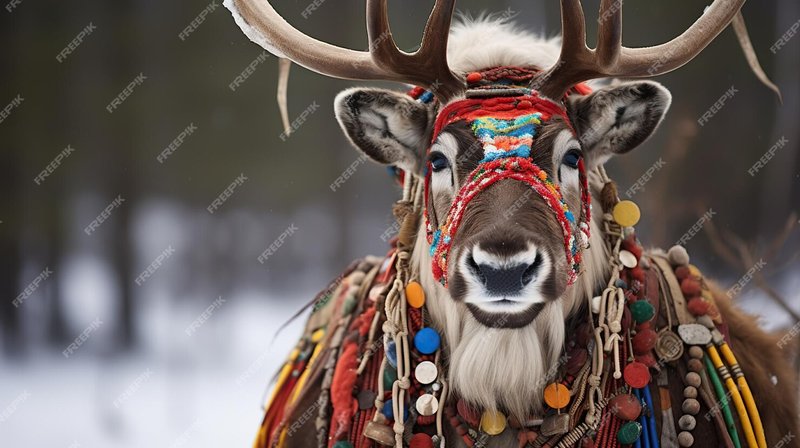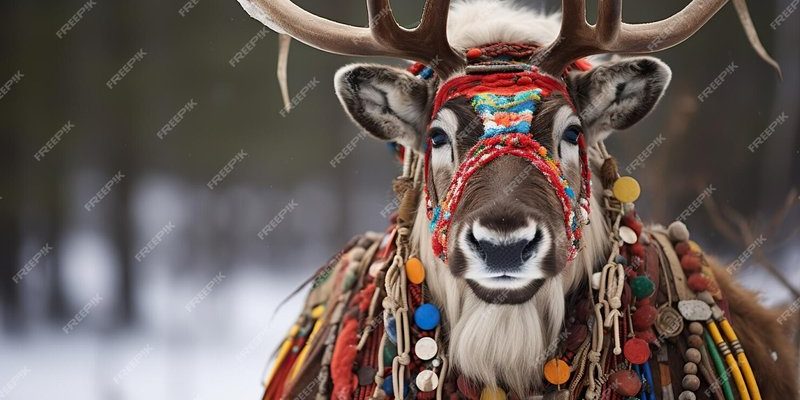
Honestly, the reindeer is like a cultural chameleon. Depending on where you look, it can signify different things. For some, they represent the magic of winter and the holiday season. For others—particularly in Indigenous cultures of the Arctic—they’re a lifeline, providing food, clothing, and materials for shelter. Let’s dive into the rich tapestry of how reindeer are represented in different cultures and folklore.
Reindeer in Norse Mythology
Norse mythology is filled with fascinating tales, and reindeer play a small yet significant role. In ancient Scandinavia, these graceful animals were often associated with the god Odin, who was sometimes depicted riding a horse with antlers, reflecting the magical essence of the reindeer.
In the cold, dark winter months, reindeer were not just essential for sustenance but also for spiritual survival. They were believed to represent strength and resilience in harsh environments. In fact, many Norse stories include reindeer as part of the mythical landscape, often intertwined with the lives of gods and heroes.
You might be wondering why they’re so significant in these tales. The reindeer’s ability to thrive in extreme cold made it a symbol of perseverance, something every Norse warrior admired. And let’s face it—who wouldn’t love a creature that can thrive where most struggle?
Reindeer and Indigenous Cultures
Indigenous peoples in the Arctic regions, particularly the Sámi in Scandinavia, view reindeer as more than just animals; they are central to their cultural identity. For the Sámi, reindeer herding isn’t just a livelihood; it’s a way of life that’s been passed down through generations.
These communities have a profound relationship with reindeer, relying on them for food, clothing, and even tools. Their deep respect for the animal is reflected in traditional songs, stories, and everyday practices. The migration patterns of reindeer are carefully observed and celebrated, giving rise to festivals that honor this unique bond.
Here’s the thing: the Sámi believe that reindeer have a spirit. They hold ceremonies to honor these creatures when they hunt them, ensuring that nothing goes to waste. This connection illustrates a profound respect for nature—a lesson that we could all benefit from in our fast-paced lives.
Reindeer in Christmas Traditions
Ah, Christmas! Who could forget the images of Santa Claus and his trusty reindeer flying through the sky? This modern association largely stems from Clement Clarke Moore’s poem, “A Visit from St. Nicholas”, first published in 1823. In this piece, he famously names the reindeer, even giving them personalities that have stuck with us.
In many Western cultures, these reindeer symbolize the joy and spirit of giving during the holiday season. They’ve become icons of Christmas cheer, connecting us to the magic of childhood and the thrill of the holiday.
But here’s where it gets interesting: the concept of a magical sleigh is not just confined to the West. In various cultures across the Arctic, including the Sámi, there are similar stories where the reindeer play a pivotal role in winter celebrations, reflecting their importance in both folklore and everyday life.
Reindeer in Folklore Across the World
Reindeer have made their way into the folklore of many cultures, adapting to fit regional stories and beliefs. In Russian folklore, there are tales of reindeer guiding the spirits of ancestors, serving as a bridge between the physical world and the spiritual realm. They are often depicted as wise, magical creatures, much like how the Baba Yaga rides in her mortar, embodying the mystique of the forest.
In North America, some Indigenous tribes also incorporate reindeer into their stories, although they might refer to them as caribou. The themes often revolve around survival, respect, and the interconnectedness of all living things, reminding us that nature is not just a backdrop but a vital part of our existence.
Honestly, it’s fascinating how a single creature can find itself at the heart of so many narratives. These stories invite us to reflect on our relationship with nature and the importance of respecting the wildlife around us.
Symbolism of Reindeer in Art and Literature
You’ve probably noticed that reindeer often pop up in art and literature, not just in seasonal decorations. In various forms of art, they symbolize fertility, abundance, and the beauty of the wild. From ancient cave paintings to modern illustrations, these animals evoke a sense of wonder.
Artists often portray reindeer in winter landscapes, capturing their elegance against the backdrop of snow-covered forests. This representation serves as a reminder of the stark beauty of winter and the resilience of life in even the harshest conditions.
Literary references to reindeer, too, often highlight their majestic qualities. Authors use them to explore themes of freedom, survival, and the bond between humans and nature. A common thread in these stories is the idea that reindeer embody not just physical strength but also emotional warmth, reminding us of the comfort we find in nature.
Modern Interpretations and Conservation
In today’s world, the view of reindeer is shifting, especially as we become more aware of conservation efforts. As climate change threatens their natural habitats, many cultures are re-evaluating how they view and interact with these animals.
Conservation programs focusing on reindeer aim to protect their habitats and promote sustainable herding practices. This is not just about preserving a species; it’s about respecting the cultures that revolve around them. Initiatives often include educational programs to raise awareness about the importance of biodiversity and the delicate balance of our ecosystems.
You might wonder, what does this mean for the future? It points to a growing recognition of the need to preserve not just the reindeer but also the rich cultural stories that surround them. Their survival is intertwined with the lives of Indigenous peoples, making this a global issue that transcends borders.
As we’ve explored, reindeer are so much more than holiday symbols. They hold a special place in various cultures, from Norse mythology to Indigenous practices, reflecting our rich narrative of life, survival, and interconnectedness.
Whether they are soaring through the winter sky or grazing in the tundra, reindeer remind us of the harmony that can exist between humans and nature. As we continue to tell their stories, let’s embrace the lessons they offer: respect, resilience, and the magic of the natural world.
So, the next time you see a reindeer—whether in a storybook, a beautiful piece of art, or even in the wild—take a moment to appreciate not just the creature itself, but everything it represents across cultures and time.

